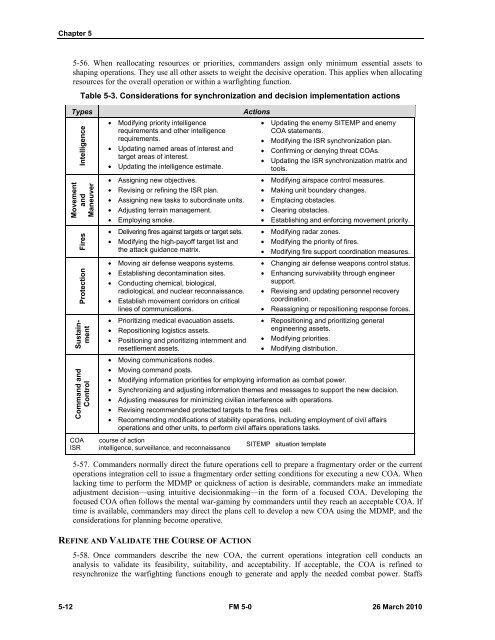FM 5-0, The Operations Process - Federation of American Scientists
FM 5-0, The Operations Process - Federation of American Scientists
FM 5-0, The Operations Process - Federation of American Scientists
You also want an ePaper? Increase the reach of your titles
YUMPU automatically turns print PDFs into web optimized ePapers that Google loves.
Chapter 5<br />
5-56. When reallocating resources or priorities, commanders assign only minimum essential assets to<br />
shaping operations. <strong>The</strong>y use all other assets to weight the decisive operation. This applies when allocating<br />
resources for the overall operation or within a warfighting function.<br />
Table 5-3. Considerations for synchronization and decision implementation actions<br />
Types<br />
Intelligence<br />
Movement<br />
and<br />
Maneuver<br />
Fires<br />
Protection<br />
Sustainment<br />
Command and<br />
Control<br />
COA<br />
ISR<br />
• Modifying priority intelligence<br />
requirements and other intelligence<br />
requirements.<br />
• Updating named areas <strong>of</strong> interest and<br />
target areas <strong>of</strong> interest.<br />
• Updating the intelligence estimate.<br />
• Assigning new objectives.<br />
• Revising or refining the ISR plan.<br />
• Assigning new tasks to subordinate units.<br />
• Adjusting terrain management.<br />
• Employing smoke.<br />
• Delivering fires against targets or target sets.<br />
• Modifying the high-pay<strong>of</strong>f target list and<br />
the attack guidance matrix.<br />
• Moving air defense weapons systems.<br />
• Establishing decontamination sites.<br />
• Conducting chemical, biological,<br />
radiological, and nuclear reconnaissance.<br />
• Establish movement corridors on critical<br />
lines <strong>of</strong> communications.<br />
• Prioritizing medical evacuation assets.<br />
• Repositioning logistics assets.<br />
• Positioning and prioritizing internment and<br />
resettlement assets.<br />
Actions<br />
• Updating the enemy SITEMP and enemy<br />
COA statements.<br />
• Modifying the ISR synchronization plan.<br />
• Confirming or denying threat COAs.<br />
• Updating the ISR synchronization matrix and<br />
tools.<br />
• Modifying airspace control measures.<br />
• Making unit boundary changes.<br />
• Emplacing obstacles.<br />
• Clearing obstacles.<br />
• Establishing and enforcing movement priority.<br />
• Modifying radar zones.<br />
• Modifying the priority <strong>of</strong> fires.<br />
• Modifying fire support coordination measures.<br />
• Changing air defense weapons control status.<br />
• Enhancing survivability through engineer<br />
support.<br />
• Revising and updating personnel recovery<br />
coordination.<br />
• Reassigning or repositioning response forces.<br />
• Repositioning and prioritizing general<br />
engineering assets.<br />
• Modifying priorities.<br />
• Modifying distribution.<br />
• Moving communications nodes.<br />
• Moving command posts.<br />
• Modifying information priorities for employing information as combat power.<br />
• Synchronizing and adjusting information themes and messages to support the new decision.<br />
• Adjusting measures for minimizing civilian interference with operations.<br />
• Revising recommended protected targets to the fires cell.<br />
• Recommending modifications <strong>of</strong> stability operations, including employment <strong>of</strong> civil affairs<br />
operations and other units, to perform civil affairs operations tasks.<br />
course <strong>of</strong> action<br />
intelligence, surveillance, and reconnaissance<br />
SITEMP situation template<br />
5-57. Commanders normally direct the future operations cell to prepare a fragmentary order or the current<br />
operations integration cell to issue a fragmentary order setting conditions for executing a new COA. When<br />
lacking time to perform the MDMP or quickness <strong>of</strong> action is desirable, commanders make an immediate<br />
adjustment decision—using intuitive decisionmaking—in the form <strong>of</strong> a focused COA. Developing the<br />
focused COA <strong>of</strong>ten follows the mental war-gaming by commanders until they reach an acceptable COA. If<br />
time is available, commanders may direct the plans cell to develop a new COA using the MDMP, and the<br />
considerations for planning become operative.<br />
REFINE AND VALIDATE THE COURSE OF ACTION<br />
5-58. Once commanders describe the new COA, the current operations integration cell conducts an<br />
analysis to validate its feasibility, suitability, and acceptability. If acceptable, the COA is refined to<br />
resynchronize the warfighting functions enough to generate and apply the needed combat power. Staffs<br />
5-12 <strong>FM</strong> 5-0 26 March 2010















